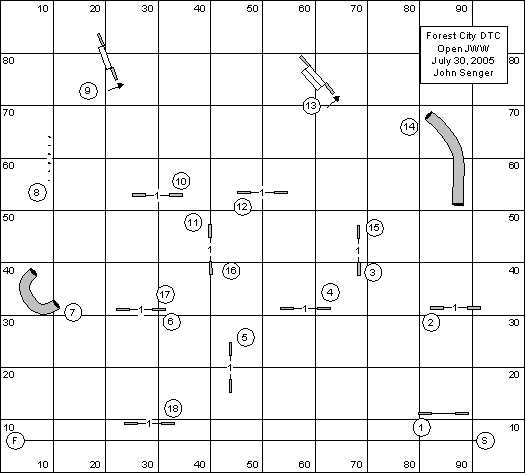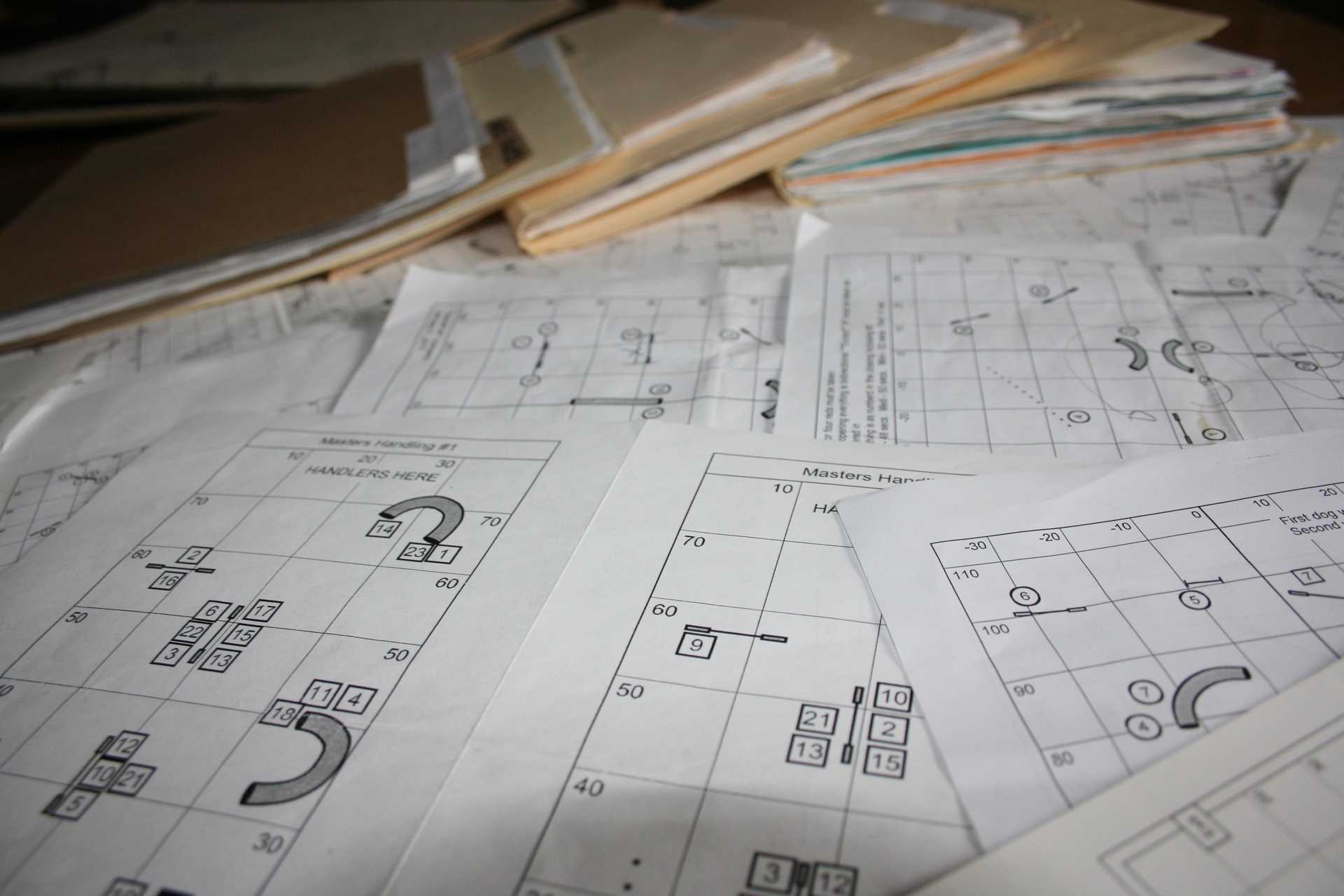John Senger - AKC Open Jumpers With Weaves
12 Aug 2005
I ran this course (unsuccessfully :^) at the Forest City Dog Training Club AKC Trial
a couple weekends ago. I really liked it for three main reasons: it had a nice “flow”, it has subtle off courses and lastly, it offered multiple handling options. In fact I liked this course so much I used part of the opening sequence for last week’s Dearlove Agility class course. The judge and designer was John Senger from the East Coast. John was kind enough not only to let me post his course, but he also sent me the Clean Run Course Designer file. Thanks a lot John!

Running The Course
As you can see, the opening is a single jump and then into two three jump Pin Wheels back-to-back that share a common jump (jump 4). There is another three jump Pin Wheel starting at jump 10. The close is a long jump run with a slight jog back to the handler for the final jump.
I put all the handling options in a single diagram below:

There were three primary approaches to the opening, shown as black, green, and blue handler paths. The black dashed line shows the handler approach I took. It was to Lead Out slightly and then Push on the dog’s line to get them over jump 3. Then Front Cross Learning the Front Cross - VideoFront Cross over jump 4. At that point a fast dog is ahead of the handler and a Rear Cross Learning the Rear CrossRear Cross is used to turn the dog into the correct side of the tunnel. The problems with this approach can include: not pushing the dog out far enough to get them over jump 3, being late for the Front Cross and being the dog’s way (although the smart handler could Rear Cross once they saw they were late), and the final Rear Cross could send the dog on line for the wrong side of the tunnel (see the red dog path). It is conceivable a fast handler could be in position for a Front Cross on the take off side of jump 6; although I didn’t see anyone try this.
The green handler path was used by a few handlers and I think I would have more successful had I tried it. The key difference is putting the Front Cross on the landing side of jump 3. Then by staying on the far side of jumps 4-5-6 the handler takes a shorter and possibly faster path than the dog. This could allow the fast handler to “scoop” the dog coming over jump 6 and push them into the correct side of the tunnel. Failing to beat the dog to the landing side of jump 6, the handler could Rear Cross to the take off side of jump 6 as the dog was committed to jump 6; this would give a strong physical cue to the dog to turn tight over jump 6.
The blue handler path is the most “conservative” approach. A Post Turn Learning the Post TurnPost Turn/Shoulder Pull/Pivot Turn through the first Pin Wheel and then Rear Crossing jumps 4 and 6. I tend not to take this approach as I don’t want to give up opportunities to get ahead of Milo on course, he is so fast that once I get behind there is little I can do to influence his path. But for the right teams this was a very successful approach.
Out of the tunnel it was through the weaves and over the double. Handlers had to be aware of not accelerating too much towards the double, it only served to send the dogs wide over the jump as shown by the red dog path. I believe most handlers used a Front Cross on the landing side of the double to tighten the dog’s path into the Pin Wheel. Although a Post Turn/Rear Cross would work if the handler was comfortable being behind their dog at that point.
A wide turn off the double jump complicated the Pin Wheel handling. The dog’s angle to the jump, together with their high speed over the 30+ foot run, caused dogs to not see jump 11 as they approached jump 10. So the dogs either went towards the off course jump 17 and couldn’t make the turn to 11 in time or made the turn over 11 and went wide of jump 12 (both shown as red dog paths). So this was a good example where setting the dog’s path earlier in a sequence greatly affected the dog’s ability to complete the sequence.
Once the dogs got out of the final Pin Wheel it was a pretty straight forward speed run over the triple jump (handled with a Rear Cross on the take off side), through the tunnel and then running over jumps 15 and 15. The tricky part was getting the dog from 16 through 17 and 18. As the dogs were getting ahead of their handler’s on this fast sequence, the dog’s tended to go wide of jump 18 unless the handler called the dog to come back towards them. The natural desire of most dog’s to curl back towards their handlers helped a number of teams. Although there were some dogs that ran by the final jump. Getting over the last jump was made a little more difficult by the proximity of jump 5, handler’s presence tended to push on the dog’s line as the dog came over jump 17 and could push the dog past jump 18.
As I said before this was a fun course to run. I’ll have to find a space where I can set it up to run it again. Thanks again John!
If you enjoyed this article won't you please:  Thanks!
Thanks!
